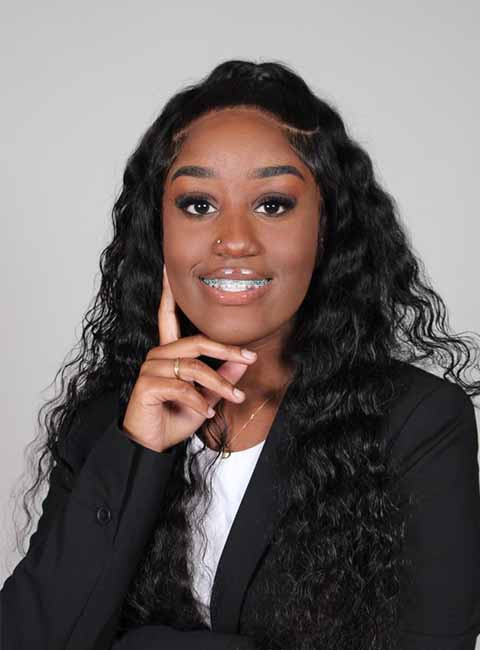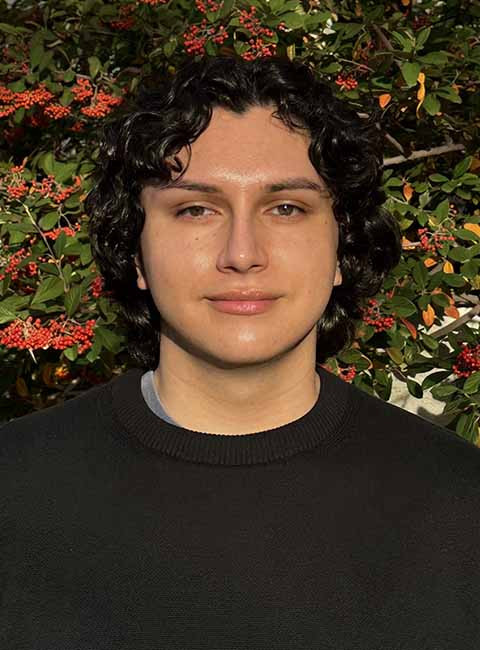
The TRB Minority Student Fellows Program, established by The Transportation Research Board (TRB) and the U.S. Federal Highway Administration (FHWA) in 2010, aims to actively explore research, ideas, and solutions from diverse perspectives. This program seeks to increase the number of underrepresented communities in the transportation field and in TRB activities.
In celebration of our commitment to developing future transportation leaders and in honor of our former President and CEO, Lance Neumann, Cambridge Systematics launched an annual scholarship program in 2021 to help two TRB Minority Student Fellows travel to and attend the TRB Annual Meeting to present their research.
Introducing our scholarship recipients for 2025: Mauricio Pérez and Demaya Jenkins. We had the opportunity to ask them about their research and the changes they hope to see in transportation.

Demaya Jenkins is pursuing her bachelor's degree in construction engineering technology at Florida A&M University.

Mauricio Pérez is pursuing his bachelor's degree in civil engineering at the University of New Mexico.
What’s your favorite transportation-related fact and why?
Demaya: Yellow is more attention-grabbing than red, so American school buses were made yellow. This fact is interesting because it highlights how color psychology influences design choices. While red is often associated with warning or danger, yellow is more visible and catches attention more effectively, especially in low light or from a distance. The decision to make American school buses yellow was strategic, ensuring that the buses stand out on the road to increase safety and visibility. This makes it easier for drivers to spot school buses and for students to be seen. It’s a fascinating example of how human perception is considered in everyday design for public safety.
Mauricio: One of my favorite transportation-related facts is about the first-ever high-speed train, the Tōkaidō Shinkansen, also known as the bullet train in Japan, which began operation in 1964. Its creation was a pivotal part of Japan’s post-World War II recovery efforts, aimed at rebuilding the economy and improving connectivity across the country. Railways were chosen for their efficiency and availability as a reliable mode of transportation. This initiative was further supported by government policies that promoted rail travel as a key strategy for economic recovery and regional integration.
What makes this especially fascinating is that, despite the immense challenges of reconstruction, Japan prioritized connectivity and innovation. As a result, it now has one of the most advanced and efficient public transportation systems in the world, particularly in urban areas. The Shinkansen is a shining example of how thoughtful planning and strategic investment in infrastructure can reshape a nation’s transportation landscape and set a global standard.
Check out Demaya and Mauricio’s presentations during the TRB Minority Student Fellows Poster Session
January 7th, 2025
10:15am-12:00pm
Convention Center, Hall A
Demaya: Bridging the Gap: Understanding Rural Commuting Patterns and Transportation Choices
Maurico: Identifying Disparities in Albuquerque’s Bicycling Infrastructure Network
How did you come across your research topic for your presentation at the TRB Annual Meeting, and what excites you about it?
Demaya: This topic was introduced to me by my professors, and I found it particularly interesting because it touches on important issues of equity in transportation. Rural areas often face unique challenges when it comes to accessibility and reliable transportation options. By addressing these issues, we can ensure that individuals in rural communities have the same opportunities and mobility as those in urban areas. Improving transportation in these regions is crucial for enhancing access to education, healthcare, and employment. I believe that addressing transportation equity will have a lasting impact on the well-being of underserved communities. This topic has inspired me to consider how we can create more inclusive and efficient transportation systems for everyone.
Mauricio: I came across my research topic through discussions with my mentor, Dr. Lisa Lorena Losada-Rojas. During our conversations about my interests in transportation, we explored environmentally friendly and health-promoting modes of transportation that could be better integrated into our communities. This aligns closely with one of Dr. Losada-Rojas’s missions within Rural and Urban Transportation Advancement to Healthier Communities (RUTA-HC), which aims to develop transportation solutions that improve community health through behavioral changes. When she asked if bicycling interested me as a research focus, I explained it did. This led us to explore this topic further and later on research it.
What excites me about this research is that bicycling is an affordable and accessible mode of transportation, which is particularly relevant to my community in Albuquerque, New Mexico, where poverty rates exceed the national average. Beyond its affordability, bicycling offers significant health benefits, meaning it offers an overall contribution to the economic and physical well-being of individuals. An idea that excites me is designing infrastructure that prioritizes cycling and other sustainable, human-centered transportation options to foster healthier and economically stable communities.
What drew you to this field, and how can the industry encourage more students to pursue a career in transportation?
Demaya: As a student in the construction program, I want to help improve transportation systems to make them safer, more efficient, and accessible for everyone. I was drawn to this field because of the vital role transportation plays in everyone’s daily life. Transportation impacts how people get to work, school, and healthcare, and I believe that improving these systems can lead to stronger, more connected communities.
To encourage more students to pursue a career in transportation, the industry could raise awareness about its importance in creating equal opportunities for all. Highlighting how transportation affects various aspects of daily life and showing students the direct impact they can have on improving communities would inspire more interest. Providing more hands-on experiences, research opportunities, and internships in the field would also help students see the potential of a career in transportation and how they can contribute to solving real-world problems.
Mauricio: I was drawn to the field of transportation from an early age, as I often found myself fascinated by maps and roads, which created a variety of unique spaces. I envisioned a cyberpunk-inspired future society where transportation could take on various innovative forms and shapes. This fueled my curiosity and interest in the possibilities within this field.
To encourage more students to pursue careers in transportation, I believe the industry should focus on presenting exciting opportunities for revolutionary and transformative modes of transportation. Unfortunately, I believe that in the U.S., there is often a heavy emphasis on the economic aspects of transportation, which can inhibit the development of innovative systems and instead perpetuate reliance on outdated modes. This focus on maintaining the status quo often limits the imagination and appeal of the field.
I believe the transportation industry should shift its focus toward fostering innovation and promoting environmentally friendly and forward-thinking solutions. While I’ve decided to explore a different path in my career, transportation and transportation-related research continue to pique my interest because of their potential to create meaningful societal change.
What kind of changes do you hope to see in transportation in the next 10 years?
Demaya: In the next 10 years, I hope to see significant improvements in transportation, particularly in rural areas, by expanding transit systems to provide better access to education, healthcare, and employment. I also hope to see a decrease in fatalities, especially among teen drivers, through improved road designs, better driver education, and increased safety measures. Additionally, I would like to see more pedestrian-friendly environments with safer sidewalks, crosswalks, and bike lanes to encourage walking and cycling while reducing the risk of accidents. These changes would create safer, more accessible, and sustainable transportation systems for all.
Mauricio: In the next 10 years, I hope to see transportation evolve in a way that prioritizes people and the environment over cost savings. I envision a stronger push for the integration of public transportation and "micro-mobility" options such as bikes and scooters. These changes could foster a greater sense of community in local areas while promoting healthier, safer, and more economically stable neighborhoods.
I also hope to see a significant decrease in the dependence on cars, with the development of denser, more interconnected communities supported by efficient, human-centered transportation systems. In the future, I want transportation to move away from simply getting people from point A to point B. Instead, it should embrace the concept of making the journey itself a meaningful and enriching experience.
If someone would like to get in touch, what’s the best way to connect with you?
Demaya: The best way to reach me is via LinkedIn.
Mauricio: The best way to contact me would be on LinkedIn.
Thank you both for taking the time to speak with us. We hope you have a wonderful time at the TRB Annual Meeting, and we can’t wait to hear about what you’ll accomplish in the next steps of your transportation careers!